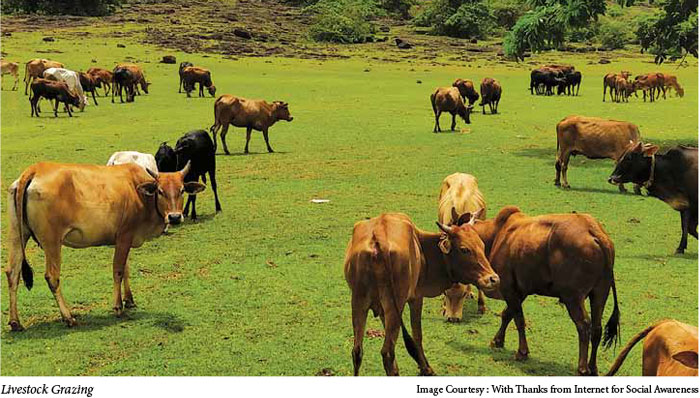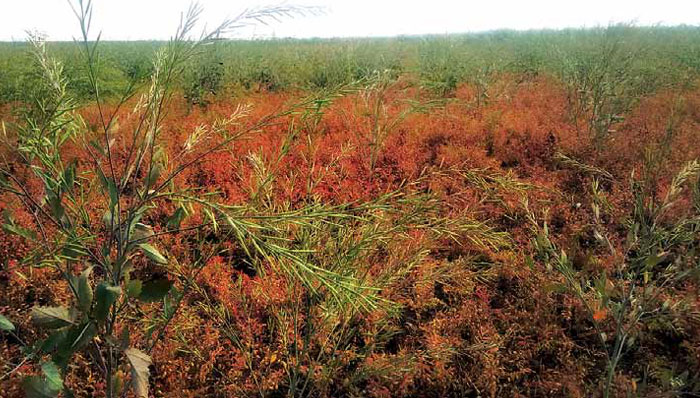
Crop Raiding
Compensation Procedure, Package & Implications in Madhya Pradesh
By Gaurav Khare
The consequences of human wildlife conflict have various dimensions, but crop loss from wildlife is a phenomenon that not only impacts the farmer’s life economically but it has impacts which are beyond financial economics. It is one of the most adverse impacts of human wildlife conflict because it not only affects the livelihood of farmers but also jeopardize the objectives of wildlife conservation. The areas in close proximity of forest areas and National parks are more vulnerable for incidents of crop raiding. Various State Governments have provisions for providing compensation to the farmers affected from crop losses by wildlife. But there are various issues related to the compensation procedures, compensation packages and their effectiveness. This is why it’s very important to analyze and understand the problem of crop raiding and compensation distribution together in a comprehensive manner. Mitigation measures used for prevention of crop raiding by wildlife and effective compensation mechanism to cover the losses, both these aspects are very important for conservation efforts to be successful.
Prior to the study the State of Madhya Pradesh was not having any separate provision for compensation for crop loss from wildlife, the compensation rates are decided according to the Revenue Book Circular Section 6 Number 4 (6-4), Annexure 1 (A), 2018 which are the rates for crop loss from natural disasters. Due to this there are various issues related to the existing compensation scheme. Also, the procedure for loss compensation is very complex, due to the involvement of multiple stakeholders i.e. the Revenue department and the Forest department.
In the above context, a realistic assessment is extremely important in the longterm interest of conservation.This study is an effort to address the issues arising from destruction to standing crops on farmers’ fields by wildlife and review the range of Government orders governing the loss compensation regime and the procedures followed in the field both by the Revenue and Forest Departments and come up with recommendations for their simplification. The objectives of the study are as follows:
To review the existing rules and procedures for providing loss compensation to farmers who suffers damage to their standing crops caused by wildlife and,
- Recommend simplification of the procedure for affected farmers to apply for and obtain loss compensation,
- Assess and suggest modifications to the compensation package, both in terms of its coverage and rates,
- To make an assessment of the shortand long-term impacts of incidents of crop damage and the local administration’s response mechanism on the larger narrative of human-wildlife conflict.
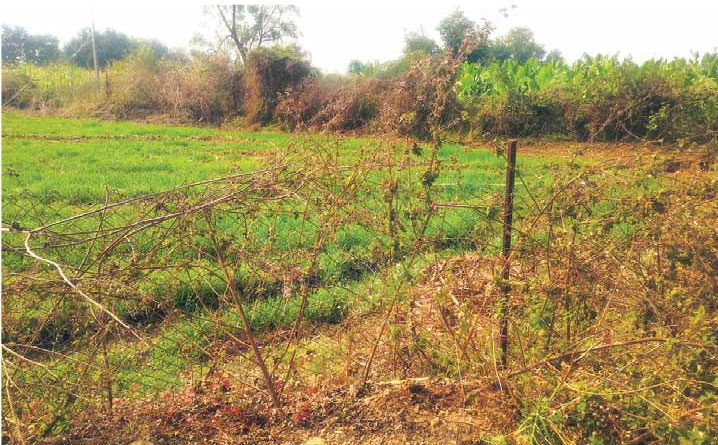
Methodology
This exploratory research is both qualitative and quantitative in nature, utilizing questionnaires, focus group discussions, semi-structured interviews and expert opinions, for analyzing all the aspects associated with the phenomena of crop raiding. The districts have been selected on the basis of purposive sampling, which include Neemach, Panna, Burhanpur, Chhindwara, and Chhatarpur. The outcomes of the study include recommendation for a simplified procedure for crop loss compensation and suggestion for a more inclusive package both in terms of its coverage and rates, along with various measures that can be adopted in short and long term duration to mitigate the incidences of crop raiding.
Data required for analysis has been collected from various primary and secondary sources. The quantitative data collection was done through Household Survey method using structured questionnaires. The qualitative data was collected by conducting focus group discussions (FGDs) and semi structured interviews with the different stakeholders. Detailed questionnaires were developed for beneficiaries and officials of related departments. Questionnaires were prevalidated through a pilot testing of the same in Hoshangabad district. Secondary data collection was done from various departments, websites, books, journals papers and reports. Sampling was done using the data received from district administration of sampled districts regarding number of crop raiding cases received in the last three years.The analysis and results are represented in the form of various graphs and charts. Basis statistical methods wherever required and found appropriate like arithmetic mean and rating using Likert scale have also been utilized in the analysis.
Key Findings:
- Frequency and Pattern of Invasions: On an average there are about 21-22 incidents of crop raiding happening per month with variations according to seasons. Respondents were of the view that pattern of crop raiding has changed with a greater number of crop raiding incidents happening than previously
- Periodicity of Invasions and Animals mostly involved: Crop raiding incidents are high during the Kharif season (71%) between the months of July to September and in Rabi season (47%) from January to March.Wild boar (100% responses) is the most problematic animal which is involved in the crop raiding. After that Blue bull is involved in 29% of the cases.
- Crops mostly destroyed: It includes Corn, Wheat, Gram, Sugarcane, pulses etc. Corn is the most destroyed crop with 73.68% responses, followed by Wheat (44.74%) and Gram with 36.84%.
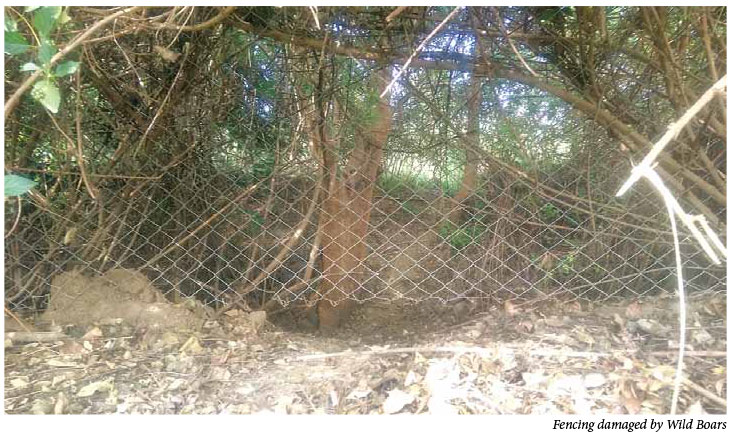
- Source of Information and incidence reporting: For 53% respondents the source of information was Forest department followed by Revenue department (37%). The first point of contact was Revenue department for 84% respondents followed by forest department (42.1%).
- Problems in compensation procedure : Lack of knowledge (61%) and lack of information sharing (29%) are two major reported problems by respondents. The average time taken in whole procedure is about 208 days with major delaying part being compensation payment which takes about 199 days. The average expenditure is about Rs. 277/- with highest expenditure being on the travel cost (Rs. 127/-).
- Crop damage verification and assessment: In 63% cases the damage verification is done by Revenue officer / Patwari, followed by forest officers / Beat guard with 31% cases. In 97.37% of the cases damage assessment is done by Revenue officer/Patwari. In 89% of the cases damage assessment is done visually based on personal assessment.
- Compensation amount: The percentage of compensation received against crop loss is 17% which means that the compensation amount received by farmers is only 17 % of the actual loss
- Mitigation measures: 89% respondents use some kind of protective measures against crop raiding. Night watching (73.68%) is the most used protective measures followed by light/ fire-crackers (63.16%) and fencing (42.1%). In terms of effectiveness fencing is found to be most effective followed by night watching, as reported by respondents.
- Short and long term impacts of crop raiding: Incidents of crop raiding leads to a change in the mindset of people about wildlife. These incidents have various short and long term economic, socio-cultural impacts on farmers’ life, health, children’s’ education etc. Other major findings include complexity of compensation procedure, multiplicity of authorities, irregularities in crop damage verification and assessment, inadequacy and complexities of the compensation package.
Key Recommendations:
- The findings of the data analysis reveal that reliability and trust of people is more over the forest department and since forest department is already handling the other three compensation schemes of human wildlife conflict i.e. human death, human injury, livestock death or injury etc. the entire process of handling the crop raiding cases should be handed over to forest department.
- The first point of contact for reporting crop raiding cases should be at Beat Guard level. Both channels of incident reporting i.e. offline and online through Lok Seva Kendra (LSK) should be continued with a revised application format.
- The cases with less than 50% damage should be verified and assessed by Beat guard while in the cases with more than 50% damage assessment should be carried out by Forest range officer
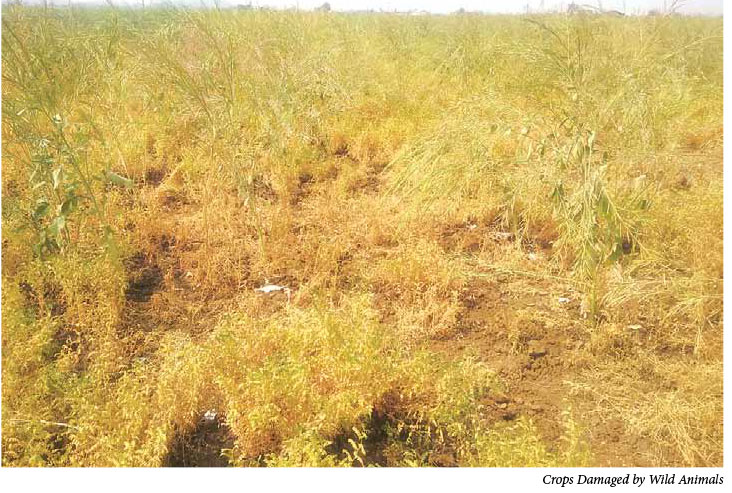
- The payment of compensation should be done by forest department itself. Divisional Forest officer (DFO) will
be the authority for sanctioning and releasing the compensation amount. Feedback mechanism along with process of appeal should be adopted in the entire process of compensation payment. - The rates of compensation should compensate for 75% of the actual loss with revisions of rates at each financial year. Lower limit of 25% loss should be replaced with minimum loss of Rs. 2000/-. The existing criteria of different rates for farmers with different landholdings and for different damage slabs should be removed.
- Various measures can be adopted by farmers to prevent incident of crop raiding using physical barriers, biological barriers and traditional methods. The physical barriers include circular razor wire fencing, barbed wire fencing, chain link fencing, and HDPE net fencing. The biological barriers include safflower and castor as barrier crops. The traditional methods include colored sari barriers, use of human hair, egg solution and animal excreta as repellant.
- Change in the cropping pattern, distribution of fencing or subsidies on fencing based on vulnerability can also be adopted as localized measures. Optional fencing as part of compensation package can also be adopted by the government.
- Capacity building programs should be organized for officials of the concerned departments. Beat guards and Forest range officers should be given training for crop damage verification and assessment. It’s also important to bring awareness among people about human wildlife conflict, crop raiding and various preventive measures. The compensation procedure along with its criteria should also be popularized among general masses.
- Crop damage by wildlife should be part of crop insurance schemes. Efforts should be made to bring it under the scheme of PMFBY (Prime Minister Fasal BimaYojna).



